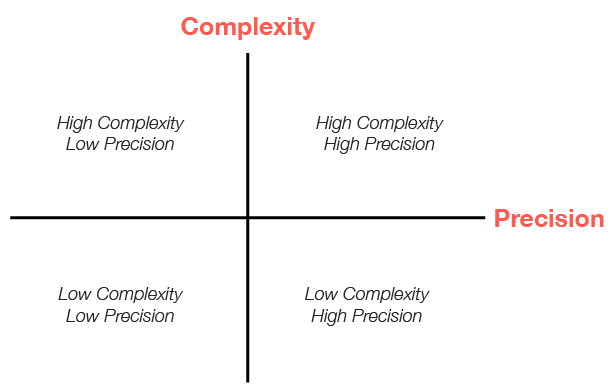理解决策框架
在使用 CrewAI 构建 AI 应用程序时,您将做出的最重要的决策之一是为您的特定用例选择正确的方法。您应该使用 Crew 吗?Flow 吗?还是两者的结合?本指南将帮助您评估需求并做出明智的架构决策。 这个决策的核心是理解应用程序中复杂性和精度之间的关系:
CrewAI 应用程序的复杂性与精度矩阵
复杂性-精度矩阵解析
什么是复杂性?
在 CrewAI 应用程序的背景下,复杂性指的是:- 所需的不同步骤或操作的数量
- 需要执行的任务的多样性
- 不同组件之间的相互依赖性
- 对条件逻辑和分支的需求
- 整体工作流程的复杂程度
什么是精度?
在此背景下,精度指的是:- 最终输出所需的准确性
- 对结构化、可预测结果的需求
- 可复现性的重要程度
- 对每一步所需的控制水平
- 对输出变化的容忍度
四个象限
1. 低复杂性,低精度
特点- 简单、直接的任务
- 对输出的一些变化有容忍度
- 步骤数量有限
- 创意或探索性应用
- 基础内容生成
- 创意头脑风暴
- 简单的摘要任务
- 创意写作辅助
2. 低复杂性,高精度
特点- 需要精确、结构化输出的简单工作流
- 需要可复现的结果
- 步骤有限但精度要求高
- 通常涉及数据处理或转换
- 数据提取和转换
- 表单填写和验证
- 结构化内容生成(JSON, XML)
- 简单的分类任务
3. 高复杂性,低精度
特点- 包含多个步骤的多阶段过程
- 创意或探索性输出
- 组件间的复杂交互
- 对最终结果的变化有容忍度
- 研究与分析
- 内容创作流程
- 探索性数据分析
- 创造性问题解决
4. 高复杂性,高精度
特点- 需要结构化输出的复杂工作流
- 多个相互依赖的步骤,具有严格的准确性要求
- 既需要复杂的处理,也需要精确的结果
- 通常是任务关键型应用
- 企业决策支持系统
- 复杂数据处理流程
- 多阶段文档处理
- 受监管行业的应用
在 Crews 和 Flows 之间进行选择
何时选择 Crews
Crews 在以下情况下是理想选择:- 您需要协作智能 - 多个具有不同专业领域的代理需要协同工作
- 问题需要涌现式思维 - 解决方案能从不同视角和方法中受益
- 任务主要是创意性或分析性的 - 工作涉及研究、内容创作或分析
- 您更看重适应性而非严格的结构 - 工作流可以从代理的自主性中受益
- 输出格式可以有一定的灵活性 - 可以接受输出结构的一些变化
何时选择 Flows
Flows 在以下情况下是理想选择:- 您需要精确控制执行过程 - 工作流需要精确的顺序和状态管理
- 应用程序有复杂的状态要求 - 您需要在多个步骤中维护和转换状态
- 您需要结构化、可预测的输出 - 应用程序需要一致的、格式化的结果
- 工作流涉及条件逻辑 - 需要根据中间结果采取不同的路径
- 您需要将 AI 与程序化代码结合 - 解决方案既需要 AI 能力也需要传统编程
何时结合使用 Crews 和 Flows
最复杂的应用程序通常会从结合使用 Crews 和 Flows 中受益:- 复杂的多阶段过程 - 使用 Flows 来编排整个过程,使用 Crews 来处理复杂的子任务
- 既需要创造力又需要结构的应用 - 使用 Crews 进行创意任务,使用 Flows 进行结构化处理
- 企业级 AI 应用 - 使用 Flows 管理状态和流程,同时利用 Crews 进行专业工作
实用评估框架
要为您的特定用例确定正确的方法,请遵循以下分步评估框架:步骤 1:评估复杂性
通过考虑以下因素,在 1-10 的范围内评估您的应用程序的复杂性:-
步骤数量:需要多少个不同的操作?
- 1-3 步:低复杂性 (1-3)
- 4-7 步:中等复杂性 (4-7)
- 8 步以上:高复杂性 (8-10)
-
相互依赖性:不同部分之间的关联程度如何?
- 很少依赖:低复杂性 (1-3)
- 一些依赖:中等复杂性 (4-7)
- 许多复杂依赖:高复杂性 (8-10)
-
条件逻辑:需要多少分支和决策?
- 线性过程:低复杂性 (1-3)
- 一些分支:中等复杂性 (4-7)
- 复杂的决策树:高复杂性 (8-10)
-
领域知识:所需知识的专业化程度如何?
- 通用知识:低复杂性 (1-3)
- 一些专业知识:中等复杂性 (4-7)
- 多个领域的深度专业知识:高复杂性 (8-10)
步骤 2:评估精度要求
通过考虑以下因素,在 1-10 的范围内评估您的精度要求:-
输出结构:输出必须有多结构化?
- 自由格式文本:低精度 (1-3)
- 半结构化:中等精度 (4-7)
- 严格格式化(JSON, XML):高精度 (8-10)
-
准确性需求:事实准确性有多重要?
- 创意内容:低精度 (1-3)
- 信息性内容:中等精度 (4-7)
- 关键信息:高精度 (8-10)
-
可复现性:每次运行结果必须有多一致?
- 可接受变化:低精度 (1-3)
- 需要一定一致性:中等精度 (4-7)
- 需要完全可复现:高精度 (8-10)
-
错误容忍度:错误会产生什么影响?
- 低影响:低精度 (1-3)
- 中等影响:中等精度 (4-7)
- 高影响:高精度 (8-10)
步骤 3:映射到矩阵
将您的复杂性和精度分数绘制在矩阵上:- 低复杂性 (1-4),低精度 (1-4):简单的 Crews
- 低复杂性 (1-4),高精度 (5-10):直接调用 LLM 的 Flows
- 高复杂性 (5-10),低精度 (1-4):复杂的 Crews
- 高复杂性 (5-10),高精度 (5-10):编排 Crews 的 Flows
步骤 4:考虑其他因素
除了复杂性和精度,还要考虑:- 开发时间:Crews 通常能更快地构建原型
- 维护需求:Flows 提供更好的长期可维护性
- 团队专业知识:考虑您的团队对不同方法的熟悉程度
- 可扩展性要求:对于复杂应用,Flows 通常扩展性更好
- 集成需求:考虑解决方案如何与现有系统集成
结论
选择 Crews 还是 Flows——或将它们结合使用——是一项关键的架构决策,它会影响您的 CrewAI 应用程序的有效性、可维护性和可扩展性。通过从复杂性和精度两个维度评估您的用例,您可以做出符合具体需求的明智决策。 请记住,最佳方法通常会随着应用程序的成熟而演变。从能满足您需求的最简单的解决方案开始,并准备好随着经验的积累和需求的明晰化来完善您的架构。现在您有了一个框架,可以用来评估 CrewAI 的用例,并根据复杂性和精度的要求选择正确的方法。这将帮助您构建更有效、可维护和可扩展的 AI 应用程序。
后续步骤
- 了解更多关于打造高效代理
- 探索构建您的第一个 crew
- 深入了解掌握 flow 状态管理
- 查看核心概念以获得更深入的理解
